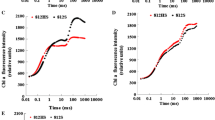Abstract
Transfer of Lemna minor fronds to culture medium containing 50% (v/v) deuterium oxide induces a large increase in the rate of protein breakdown, which is not due to an increase in the activity of acidic or neutral proteolytic enzymes or peptidases. Biochemical and ultrastructural evidence indicates that deuterium oxide affects the properties of certain membranes, particularly the tonoplast, and allows vacuolar proteolytic enzymes to pass into the cytoplasm and cause the increased protein breakdown.
Similar content being viewed by others
Abbreviations
- BAPA:
-
benzylarginine-p-nitroanilide
- LPA:
-
leucine-p-nitroanilide
- TCA:
-
trichloroacetic acid
References
Amenta, J.S., Sargus, M.J., Baccino, F.M.: Effect of microtubular or translational inhibitors on general cell protein degradation. Biochem. J. 168, 223–227 (1977)
Ashford, T.P., Porter, K.P.: Cytoplasmic components in hepatic cell lysosomes. J. Cell Biol. 12, 198–202 (1962)
Beevers, L.: Protein degradation and proteolytic activity in the cotyledons of germinating pea seeds (Pisum sativum). Phytochemistry 7, 1837–1844 (1968)
Boller, T., Kende, H.: Hydrolytic enzymes in the central vacuole of plant cells. Plant Physiol. 63, 1123–1132 (1979)
Cooke, R.J., Grego, S., Oliver, J., Davies, D.D.: The effect of deuterium oxide on protein turnover in Lemna minor. Planta 146, 229–236 (1979)
Davies, D.D., Humphrey, T.J.: Protein turnover in plants. In: Perspectives in Experimental Biology, vol. 2, pp. 313–324, Sunderland, N. ed. New York: Pergamon Press 1976
Deter, R.L., de Duve, C.: Influence of glucagon, an inducer of cellular autophagy, on some physical properties of rat liver lysosomes. J. Cell Biol. 33, 437–449 (1967)
Franke, W.W., Krien, S., Brown, R.M.: Simultaneous gluteraldehyde osmium tetroxide fixation with post-osmotication. Histochemie 19, 162–164 (1969)
Hilton, M.A., Barnes, F.W., Henry, S.S., Enns, T.: Mechanisms in enzymatic transamination. Rate of exchange of the hydrogen of aspartate. J. Biol. Chem. 209, 743–754 (1954)
Humphrey, T.J., Davies, D.D.: A new method for the measurement of protein turnover. Biochem. J. 148, 119–127 (1975)
Humphrey, T.J., Davies, D.D.: A sensitive method for measuring protein turnover based on the measurement of 2-3H labelled amino acids in protein. Biochem. J. 156, 561–568 (1976)
Johnson, C.B.: The use of density labelling techniques in investigations into the control of enzyme levels. Phytochem. Soc. Symp. 14, 225–243 (1977)
Lowry, O.H., Rosebrough, N.J., Farr, A.L., Randall, R.J.: Protein measurement with the Folin phenol reagent. J. Biol. Chem. 193, 265–275 (1951)
Matile, P.: Biochemistry and function of vacuoles. Annu. Rev. Plant Physiol. 29, 193–213 (1978)
Matile, P., Moor, H.: Vacuolation: origin and development of the lysosomal apparatus in root-tip cells. Planta 80, 159–175 (1968)
Mitchener, J.S., Shelburne, J.D., Bradford, W.D., Hawkins, H.K.: Cellular autophagocytosis induced by deprivation of serum and amino acids in Hela cells. Am. J. Pathol. 83, 485–498 (1976)
Mortimore, G.E., Neely, A.N., Cox, J.R., Guinivan, R.A.: Proteolysis in homogenates of perfused rat liver: responses to insulin, glucagon and amino acids. Biochem. Biophys. Res. Commun. 54, 89–95 (1973)
Neely, A.N., Nelson, P.B., Mortimore, G.E.: Osmotic alterations of the lysosomal system during rat liver perfusion: reversible suppression by insulin and amino acids. Biochim. Biophys. Acta 338, 458–472 (1974)
Nishimura, M., Beevers, H.: Hydrolases in vacuoles from castor bean endosperm. Plant Physiol. 62, 44–48 (1978)
Nishimura, M., Beevers, H.: Hydrolysis of protein in vacuoles isolated from higher plant tissue. Nature (London) 277, 412–413 (1979)
Segal, H.L.: Mechanism and regulation of protein turnover in animal cells. In: Current Topics in Cellular Regulation, vol. 11, pp. 183–201. Horecker, B.L., Stadtman, E.R. eds. New York, San Francisco, London: Academic Press 1976
Trewavas, A.: The turnover of nucleic acids in Lemna minor. Plant Physiol. 45, 742–751 (1970)
van der Wilden, W., Matile, P.: Isolation and characterisation of yeast tonoplast fragments. Biochem. Physiol. Pflanz. 173, 285–294 (1978)
Waber, J., Sakai, W.S.: Further studies of the ultrastructure of D2O-grown winter rye. Protoplasma 84, 273–281 (1975)
Author information
Authors and Affiliations
Rights and permissions
About this article
Cite this article
Cooke, R.J., Grego, S., Roberts, K. et al. The mechanism of deuterium oxide-induced protein degradation in Lemna minor . Planta 148, 374–380 (1980). https://doi.org/10.1007/BF00388126
Received:
Accepted:
Issue Date:
DOI: https://doi.org/10.1007/BF00388126




